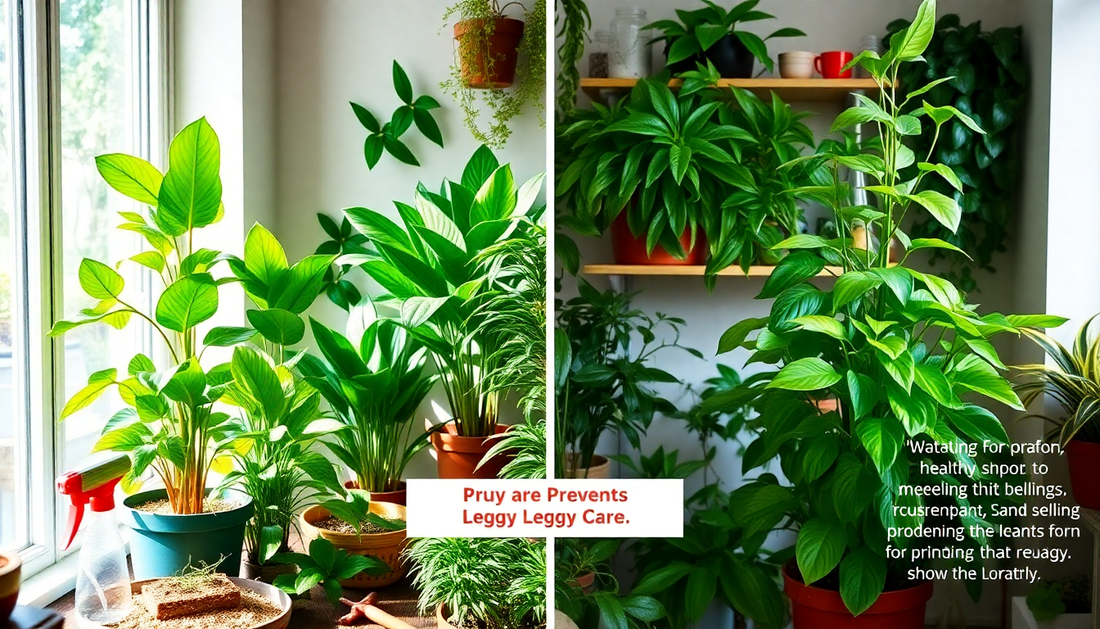
Preventing and Fixing Leggy Growth in Your Indoor Plants
As an avid indoor gardener, I've encountered my fair share of challenges when it comes to maintaining healthy, vibrant plants. One of the most common issues I've faced is the dreaded "leggy growth" - those long, spindly stems that reach towards the light, leaving your plants looking lanky and unappealing. But fear not, fellow plant enthusiasts! In this comprehensive guide, I'll share my top tips and tricks for preventing and fixing leggy growth in your indoor plants.
Understanding Leggy Growth
Leggy growth is a common problem that occurs when plants don't receive enough light. In an effort to reach for the light, the plant will stretch out its stems, resulting in a tall, lanky appearance. This can happen for a variety of reasons, such as:
- Insufficient light: If your plant isn't getting enough direct or indirect sunlight, it will try to compensate by growing taller.
- Etiolation: This is the process of a plant becoming pale and elongated due to a lack of light.
- Improper lighting: Some plants require specific lighting conditions, and if they don't get the right amount or type of light, they can become leggy.
Identifying leggy growth is relatively easy - you'll notice your plant's stems becoming longer and thinner, with the leaves spaced further apart. This can not only make your plant look unattractive, but it can also compromise its overall health and vigor.
Preventing Leggy Growth
The best way to deal with leggy growth is to prevent it from happening in the first place. Here are some effective strategies to keep your indoor plants compact and healthy:
Provide Adequate Lighting
The key to preventing leggy growth is to ensure your plants are receiving enough light. This may mean moving them to a brighter location, such as a south-facing window or under a grow light. Pay attention to the specific lighting requirements of your plant species and adjust accordingly.
Choose the Right Pot Size
Selecting the appropriate pot size for your plant is crucial. A pot that's too large can encourage leggy growth, as the plant will focus its energy on reaching for the light rather than developing a strong, compact structure. Choose a pot that's just slightly larger than the plant's root system.
Prune and Pinch
Regular pruning and pinching can help keep your plants compact and bushy. Snip off any leggy or overly long stems, and pinch back the growing tips to encourage lateral branching. This will stimulate the plant to produce more foliage and a fuller appearance.
Rotate Your Plants
If your plants are situated in a spot that receives uneven lighting, try rotating them regularly. This will ensure that all sides of the plant get an equal amount of light, preventing lopsided or leggy growth.
Fertilize Appropriately
Proper fertilization can also play a role in preventing leggy growth. Use a balanced, slow-release fertilizer and follow the recommended application rates for your plant species. Avoid over-fertilizing, as this can lead to excessive growth and leggy stems.
Fixing Leggy Growth
If your plants have already developed leggy growth, don't worry - there are ways to remedy the situation. Here's what you can do:
Prune and Repot
Start by pruning any excessively long or leggy stems. Cut them back to just above a set of healthy leaves or a node (the point where leaves or branches emerge from the stem). This will encourage the plant to produce new, compact growth.
Next, consider repotting your plant into a smaller container. This will help to restrict the plant's root system, forcing it to focus its energy on producing more compact, bushy growth.
Increase Light Exposure
As mentioned earlier, inadequate lighting is a primary cause of leggy growth. Move your plant to a brighter location, such as a south-facing window or under a grow light. Be sure to gradually acclimate the plant to the new lighting conditions to avoid shock.
Adjust Watering and Fertilization
Overwatering or over-fertilizing can also contribute to leggy growth. Review your watering and fertilization routine, and make adjustments as needed. Stick to a balanced, moderate approach to keep your plant's growth in check.
Provide Support
If your plant's stems are particularly long and weak, consider providing some support, such as a trellis or stake. This will help to keep the plant upright and prevent the stems from bending or collapsing under their own weight.
Maintaining Healthy, Compact Growth
Preventing and fixing leggy growth in your indoor plants is an ongoing process, but with the right strategies, you can keep your plants looking their best. Remember to pay close attention to your plants' lighting, watering, and fertilization needs, and don't be afraid to prune and adjust as necessary.
By following the tips outlined in this guide, you'll be well on your way to enjoying lush, compact, and visually appealing indoor plants that thrive in your home or office. Happy gardening!







No comments